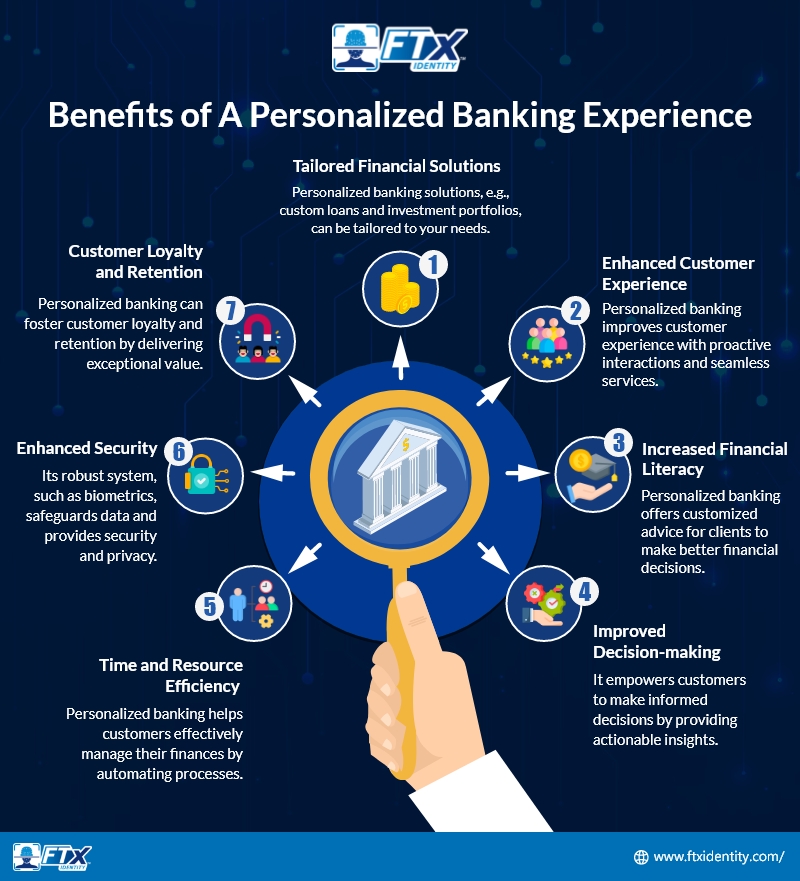Personalization has become the key to customer satisfaction in today’s fiercely competitive market. With pioneers like Amazon and Netflix paving the way, customers expect and want customized experiences.
Businesses now have the power to delight their customers through personalization technologies that significantly boost customer loyalty.
Take Spotify, for example, which creates custom playlists for its users based on their favorite songs. A recent survey from Epsilon and GBH Insights revealed that a whopping 80% of consumers crave personalization from retailers.
Certain sectors have been slower in adapting to changes than others. Financial service providers have lagged in providing personalized experiences. Many enterprises are transitioning to digital platforms to deliver their products and services.
Most people who are open to or actively looking to change their bank would consider doing their banking with a tech business like Amazon, Facebook, or Google, according to the Boston Consulting Group, if the option were presented.
As banks adapt to meet customer needs, more opportunities for fraud arise due to personalized services. Identity verification then becomes relevant as a critical element in safeguarding the safety of both customers and businesses.
Fast-changing digital consumer dynamics, stronger compliance regulations, and criminal inventiveness not seen in other industries exert significant pressure on banks and credit unions. Consumer demand for intriguing, personalized experiences is another issue.
Financial service providers can gain ground and establish themselves as strong competitors in the personalized experience market. By implementing cutting-edge identity verification technologies that interact with current systems.
Approach fintech identity verification more strategically as one piece of a broader, inter-connected puzzle that includes frictionless onboarding, fraud deterrence, and regulation. This will help institutions deliver personalization, optimize benefits, and create competitive differentiation.
What is a Personalized Banking Experience?
Traditional marketing approaches used by banks included direct mail campaigns to attract specific customers. Banks can customize their services using information from various customer interactions and transactions. This allows them to meet the specific needs of each customer.
This approach enables the creation of customized, meaningful experiences that drive customer satisfaction and loyalty.
Achieving a harmonious equilibrium between safeguarding your business against potential security threats and providing uninterrupted digital banking experiences is crucial. Moreover, you need to deliver customized banking services to meet your customer objectives.
In this scenario, the utilization of identity verification and biometrics proves beneficial. Employed correctly, they can become an asset for companies striving to provide superior customer service.
These technologies empower customers to customize financial products and services to meet their requirements. Thus, allowing them to take authority over their online interactions.
The Key Features of Personalized Banking
Personalized banking offers tailor-made solutions to meet the diverse needs of individual customers. The key features that define personalized banking and add value to customer experience are:
1. Customized Products and Services
Have you ever thought of changing your bank because of poor customer service? Well, that’s what personalized banking will ensure by providing customized products and services. These recommendations are tailored to customers’ financial goals, preferences, and lifestyles. This can include:
- Personalized loan packages
- Investment solutions
- Tailored financial solutions
- Card requirements
2. Financial Advice
A customer may need to be made aware of the bank’s products and services. This responsibility falls on the bank representative’s shoulders. They must offer personalized financial advice and guidance to ensure customers make informed financial decisions.
You can easily obtain personalized recommendations by leveraging advanced analytics, expert insights, investment strategies, etc. This helps customers with better financial planning services and achieve long-term financial objectives.
3. Seamless Omni-channel Experience
Seamless omni-channel experiences are essential for delivering personalized banking services. They seamlessly integrate across multiple channels to offer better customer service, including:
- Online banking platforms
- ATMs
- Mobile apps
- Other branches
This kind of omnichannel experience ensures customer convenience and access to banking services anytime, anywhere.
4. Predictive Services
Predictive analytics can anticipate customers’ needs and preferences, thus suggesting relevant products and services. Banks can predict future requirements by analyzing customer data, recent history, and behavior patterns.
5. Personal Touch
Personalized banking fosters deeper connections with their customers and builds trust. It also encourages customers to trust their financial institutions. By prioritizing customers’ needs, personalized banking strengthens relationships and offers exceptional customer service to effectively address individual needs and concerns.
Benefits of Personalized Banking Experience

Personalized banking experience is changing the way individuals manage their finances. Here are a few of the benefits that can cater to your customer’s unique needs and preferences:
1. Tailored Financial Solutions
Individuals can access personalized banking solutions tailored to their specific needs, ranging from loan options to investment portfolios.
2. Enhanced Customer Experience
Personalized banking enhances customer experience with tailored interactions, proactive assistance, and seamless service across multiple channels. Financial institutions can build deeper connections and trust by understanding clients’ preferences and anticipating their needs.
3. Increased Financial Literacy
Personalized banking empowers customers to make informed financial decisions by offering customized advice, educational resources, and interactive tools. This also helps enhance their understanding of financial concepts and strategies for better outcomes.
4. Improved Decision-Making
Personalized banking improves a customer’s decision-making power by providing actionable insights and recommendations. Customer data and their data analytics can offer customized recommendations and guide them toward better financial planning.
5. Time and Resource Efficiency
It is incredibly time-consuming to read and understand investment portfolios. How simple is the task when the financial institute handles all these activities?
Personalized banking streamlines the banking process, saving customers time and resources. It offers customized solutions suitable to the customer’s individual needs.
Personalized banking helps customers manage their finances more effectively without worrying about investing time and reducing the need for manual intervention.
6. Enhanced Security
Personalized banking prioritizes data security and privacy by implementing robust security measures, such as:
- Advanced encryption technologies
- Multi-factor authentication
- Biometrics (fingerprint, facial recognition, etc.)
By enforcing such security measures, banking personalization builds confidence and maintains the integrity of customer data.
7. Customer Loyalty and Retention
Banking personalization can increase customer loyalty and retention by delivering exceptional value and tailor-made experiences. Financial institutions can strengthen customer relationships by addressing individual needs and preferences, ultimately driving long-term loyalty and advocacy.
The Future of Banking Personalization Experiences
The future of personalized banking experiences is reshaping how individuals interact with their financial institutions and manage their finances. Here are some of the key trends that are set to define the future of personalized banking experiences:
1. Advanced AI and Machine Learning
Integrating artificial intelligence (AI) and machine learning will revolutionize personalized banking experiences. They can add value to customer experience and provide immediate resolution. This also reduces the dependency on resources and can offer customers 24*7 assistance.
For example, AI chatbots and virtual assistants can provide personalized recommendations or financial advice.
Also, machine learning algorithms offer quick resolutions as they can analyze vast amounts of data to understand customer requirements.
2. Hyper-Personalization
Hyper-personalization means customers will receive tailored experiences and solutions uniquely customized to their preferences, behaviors, and financial goals.
The goal of hyper-personalization is to enhance customer satisfaction and loyalty.
For example, personalized product recommendations, customized pricing, and service offerings.
3. Blockchain for Security and Transparency
Blockchain technology can help enhance security and maintain transparency in personalized banking experiences. Blockchain-based solutions and decentralized identity can ensure:
- Integrity of transactions
- Streamlined identity verification processes
- Enhance data security and privacy
- Ensuring customer data safety, trust, and confidence
4. Augmented Reality (AR) and Virtual Reality (VR)
Augmented Reality (AR) and Virtual Reality (VR) can revolutionize how customers interact with their banks. These immersive and interactive technologies can enhance customer engagement, information sharing, and decision-making processes in personalized banking experiences.
For example, virtual banking tours and personalized financial planning simulations.
5. Data Privacy and Ethical AI
As banking becomes more personalized, customer data is becoming increasingly important. Hence, financial institutions must prioritize data privacy and ethical AI practices to safeguard customers’ personal information.
This can be achieved by:
- Adhering to ethical guidelines
- Following the government’s regulatory requirements
- Maintaining data transparency
- Obtaining user consent before any process
6. Collaboration with Fintech and Tech Giants
Collaboration between traditional financial institutions, fintech startups, and tech giants can enhance banking personalization experiences. By teaming up, banks can broaden their service offerings and provide their customers with seamless and innovative solutions.
Utilizing Biometrics and Identity Verification for Personalized Experiences
Organizations can use identity verification and biometrics to customize how they check identities. This customization is based on the type of transaction and level of risk. The toolset is flexible and has many functions. This toolset is flexible and has many functions.
Higher levels of identity verification are used. Thus, you must conduct identity checks based on the risk level.
For instance, when transferring a significant amount of money versus when a customer makes a low-risk transaction.
For instance, changing contact information in their account profile.
Identity verification and biometric technologies can effectively control fraud and risk associated with banking features. Targeted, efficient, and seamless identity verification can improve synthetic identity fraud detection and prevention.
The automation can also help with manual identity verification workflows and the client experience. Identity verification helps balance user experience and fraud costs. Thus, allowing for increased investment in growth by shifting the trade-off frontier.
Every Individual Benefits from Personalized Experiences
Doesn’t it feel great to get new movie suggestions from Netflix that match your interests? For instance, nature documentaries or 1980s comedies.
…and financial institutions and their customers can most certainly experience great satisfaction.
Consumers gain from this new kind of digital experience. Financial service providers can use anonymized customer data to improve operations, develop new products, and make data-driven decisions. This data helps them be more effective and identify growth opportunities.
Consumers have a plethora of financial service options at their disposal. Fortunately, the onboarding process has witnessed significant improvement with the advent of pioneering, digital-first competitors who’ve shaken the market.
Businesses can enhance their competitive edge and experience customer retention and attraction by implementing identity verification and biometric technologies within their digital experience.
With our age verification system, your business can be confident in its operations security. Our solution protects your customer data.
We can help ensure the safety and security of your business. We will provide a consultation and demonstrate FTx Identity. This will help you understand how to protect your business effectively.
